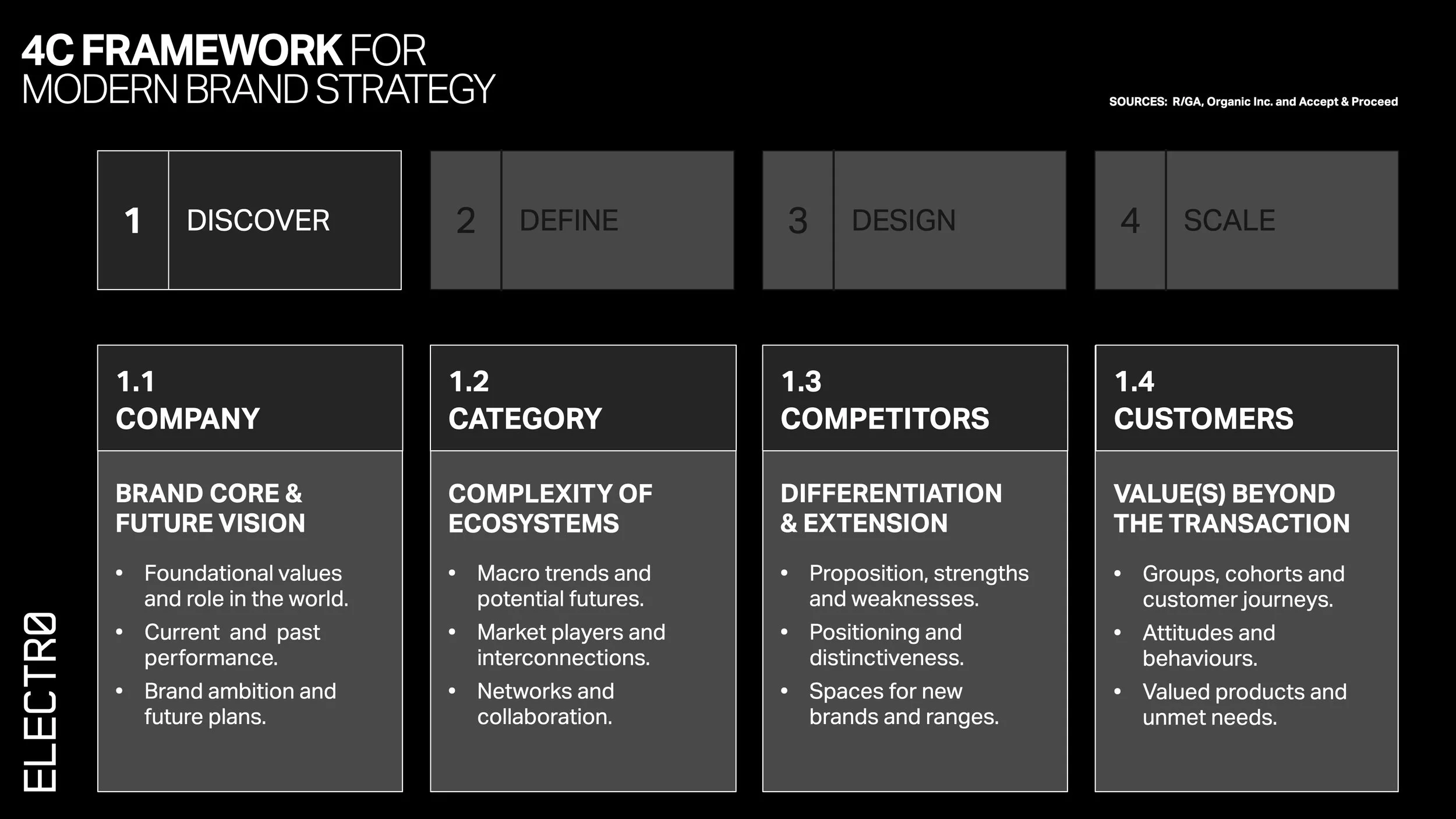THE 4C FRAMEWORK
FOR MODERN
BRAND STRATEGY
5 MINUTE READ. PUBLISHED 15 JAN 2024. UPDATED 23 OCT 2025.
CREATIVE COMMONS CC BY ELECTRO STRATEGY STUDIO. WRITTEN BY ADRIAN JARVIS.
TL;DR Modern brand strategy starts with finding foundational information and pivotal insights. There are typically four areas for exploration called the 4Cs — Company, Category, Competitors and Customers. Helping brands understand changing behaviours, evolving technology and the demands of sustainability.
A FOUNDATION FOR MODERN BRANDS.
In an uncertain world, a robust and resilient brand strategy is central to achieving sustainable growth. By using a 4C framework — such as Company, Category, Competitors, and Customers — companies can design brands that are relevant to today’s challenges and adaptable to a sustainable future.
This framework has been devised for modern brand design, though many years of practical use at studios such as R/GA, Organic Inc and Accept & Proceed. It recognises the importance of integrating brand strategy with Systems Thinking. Key aspects include:
OPERATING MANUAL. Guidance for brands to better navigate changing needs and behaviours.
CONNECTED BRANDS. Foundations for designing experiences in a modern, technology-led world.
SUSTAINABLE GROWTH. Enabling brands to be distinctive, resilient and responsible.
LET’S START WITH A FEW FAQ...
IS THIS UNIQUE TO EACH BRAND? The questions explored here are examples to show the potential topics and information that the 4C framework explores. Each audit and resulting strategic artefacts will be unique to every brand, enterprise, and challenges.
WHERE IS ‘CULTURE’? It is important to recognise there is a proliferation of often similar ‘4C frameworks’ in business, marketing and design. Specifically, in this case we have not separated ‘culture’ into its own section, as is common in advertising-led approaches. This is because we can view culture in various ways, that is integrated across the framework — from subcultures and the culture of organisations, to the shared values that connect ecosystems.
As always with brand frameworks, the right approach is the one that works for you.
SECTIONS OF THE FRAMEWORK.
1.1 COMPANY — BRAND CORE AND FUTURE VISION.
We begin by looking inwards. Conducting stakeholder interviews to gather insights, while reviewing internal documents to understand a brand's history and potential futures. This allows us to understand the current strategy and operations within the context of long-term challenges.
What are the brand's foundational values and role in the world?
What do we need to know about the company’s products, performance and practice?
What are the ambitions for the future, and is there a roadmap / plans already in place?
1.2 CATEGORY — COMPLEXITY OF ECOSYSTEMS.
Then we explore each brand as part of a larger, interconnected system. Looking at a range of entities, trends and influences — from suppliers, distributors, retailers and partners, to communities, advocacy groups and regulators.
What are the prevailing macro-trends and potential category futures?
What are the key value chains in the market and how do they meet category demand?
What is the role ecosystems and advantages of networks in the category?
1.3 COMPETITORS — DIFFERENTIATION AND EXTENSION.
We need to view competitors as not just our rivals. They are part of a wider market ecosystem. Understanding how competitors influence our brand, and vice versa. Making it clearer how to compete — and where there are points of difference.
What are competitors’ strategies, propositions, strengths, and weaknesses?
Where is the brand positioned in the market and where so we want to shift to?
Where are the spaces for building value through new brands and ranges?
1.4 CUSTOMERS — VALUE(S) BEYOND THE TRANSACTION.
We view customers as active participants, not just end-users. They are co-creators of brand value and experience. And as the world evolves, so do their needs and preferences — a rich source of insight for a more customer-centric business.
Which customer groups / segments face similar challenges or journeys?
How are attitudes, preferences, and behaviours changing?
Which products & services provide most value, and are there any unmet needs?
BRAND SYNTHESIS.
BRINGING IT ALL TOGETHER.
Through the 4Cs, we look for the links between different sources of information — using systems and brand thinking to connect the dots. Gathering different perspectives, and questioning established ways of doing business, ensures we are open to fresh thinking.
The aim is to ‘discover’ the strategic foundations to design a brand that is:
CONNECTED. Capturing the commercial and societal potential of digital transformation.
DISTINCTIVE. Finding pivotal insights that challenge norms and enable original thinking.
RESILIENT. Adapting to rapidly changing behaviour, technology, and regulations.
RESPONSIBLE. Ensuring that growth is positive for people, planet and profit.
GET IN TOUCH TO DISCUSS BRAND STRATEGY…
This article was written by Adrian Jarvis, who founded Electro, an independent strategy studio based in East London. Adrian has over 30 years experience of working with enterprises of all sizes. The principles discussed here are highly scalable from start-ups to multinationals, across a range of categories. Find out more.


